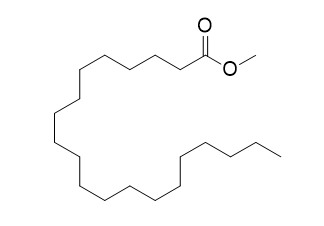Methyl arachidate
Methyl arachidate is a surfactant molecule.
Inquire / Order:
manager@chemfaces.com
Technical Inquiries:
service@chemfaces.com
Tel:
+86-27-84237783
Fax:
+86-27-84254680
Address:
1 Building, No. 83, CheCheng Rd., Wuhan Economic and Technological Development Zone, Wuhan, Hubei 430056, PRC
Providing storage is as stated on the product vial and the vial is kept tightly sealed, the product can be stored for up to
24 months(2-8C).
Wherever possible, you should prepare and use solutions on the same day. However, if you need to make up stock solutions in advance, we recommend that you store the solution as aliquots in tightly sealed vials at -20C. Generally, these will be useable for up to two weeks. Before use, and prior to opening the vial we recommend that you allow your product to equilibrate to room temperature for at least 1 hour.
Need more advice on solubility, usage and handling? Please email to: service@chemfaces.com
The packaging of the product may have turned upside down during transportation, resulting in the natural compounds adhering to the neck or cap of the vial. take the vial out of its packaging and gently shake to let the compounds fall to the bottom of the vial. for liquid products, centrifuge at 200-500 RPM to gather the liquid at the bottom of the vial. try to avoid loss or contamination during handling.
Front Microbiol.2020, 11:583594.
Journal of Physiology & Pathology in Korean Medicine.2018, 32(2): 106-112
Food Res Int.2024, 197(Pt 1):115244.
Int J Mol Sci.2022, 23(5):2796.
Bioorg Med Chem.2020, 28(12):115553.
Int J Cosmet Sci.2019, 41(1):12-20
Am J Chin Med.2016, 44(8):1719-1735
Evid Based Complement Alternat Med.2022, 2022:3483511
Pharmacol Res.2022, 182:106346.
Chemistry of Natural Compounds2019, 55(1):127-130
Related and Featured Products
Acs Earth & Space Chemistry, 2019, 3(4):571-580.
Insights into the Headgroup and Chain Length Dependence of Surface Characteristics of Organic-Coated Sea Spray Aerosols.[Reference:
WebLink]
The structure of sea spray aerosols (SSAs) has been described as a saline core coated by organic surfactants. The presence of surface-active compounds at the interface can exert significant effect on physical, chemical, and optical properties of SSAs.
METHODS AND RESULTS:
The surfactant molecules chosen for this study, palmitic acid (PA), stearic acid (SA), arachidic acid (AA), methyl palmitate (MP), methyl stearate (MS), and Methyl arachidate (MA), were used to explore the effect of alkyl chain length, headgroups, and sea salts on the surface properties of these monolayers. Surface pressure–area (π–A) isotherms obtained with a Langmuir trough was used for revealing macroscopic phase behavior of the monolayers. Moreover, infrared reflection absorption spectroscopy (IRRAS) was employed to investigate the interfacial organization at the molecular level. The π–A isotherms indicated that sea salts, present in the subphase, have an intense condensing effect on fatty acid monolayers while exerting an expanding effect on fatty acid methyl ester monolayers, which was confirmed by results from IRRAS experiments. IRRAS further uncovered the all-trans conformation of the hydrocarbon chains, which can be evidenced by the relatively low νa(CH2) and νs(CH2) stretching vibrations. The conformational order changes in the alkyl chains of different film-forming species (C16 < C18 < C20) were directly revealed by analyzing the intensity ratios of the νa(CH2) and νs(CH2) bands.
CONCLUSIONS:
Thus, all three factors alter the phase behavior and molecular packing of the monolayers at the air–aqueous interface.



